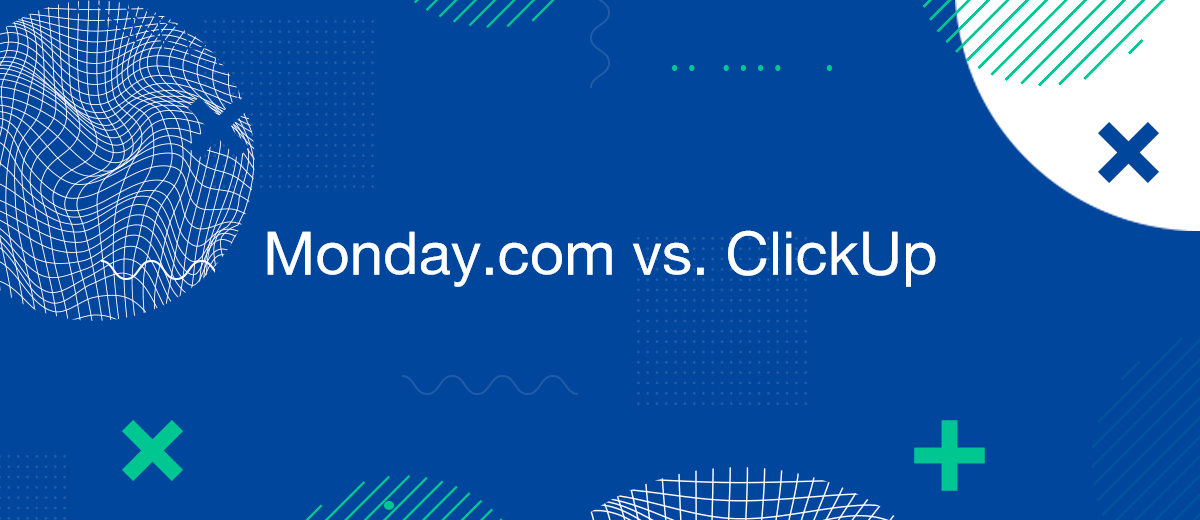Today, multifunctional systems – task managers help to manage projects, assign tasks and track their deadlines, automate workflows. Among the most famous are Trello, Asana, Monday.com, ClickUp, Todoist, Jira. Previously, we did a comparative review of Trello and Asana services, and now we invite you to pay attention to the Monday.com and ClickUp platforms. These are cloud-based SaaS solutions for efficient business project management and performance monitoring. ClickUp positions itself as a productivity service that could replace Asana and Jira. It has a powerful toolkit, enabling users to track time spent on work and achieve goals. The functionality provided by Monday.com is very similar to ClickUp. Both platforms offer numerous integrations with other useful services, and have received positive reviews and excellent user ratings. To understand which one suits you better, you should familiarize yourself with the differences between them. Our article with a detailed comparison of Monday.com vs Clickup will help you with this.
What is Monday.com
Monday.com is a cloud-based work management service that helps companies and individuals with internal process automation, project management, systematization and organization of tasks, concentrating it all on one platform. The Israeli company Wix created it in 2010. It was originally intended for internal use. In 2012, this product was isolated from the rest and even a separate company was formed for it – Dapulse. In 2017, a rebranding took place, and Dapulse became Monday.com. Today, the number of its users is 152 thousand people.

The advantage of Monday.com is flexibility. This service is suitable for managing almost any workflow: large-scale projects, customer interaction (CRM), software development, as well as personnel. The platform has a modern, intuitive interface that even completely inexperienced users can quickly “make friends with”. It is suitable for teams that need to optimize their processes, increase the efficiency of teamwork and constantly monitor their progress. Moreover, the number of participants is not relevant.
The workspace of this task manager is flexible and easily customizable, so it can be successfully used for different departments of the company: HR sector, development team, sales department and other structural units. Work on projects here is usually carried out on boards made in the form of kanban, Gantt charts, charts or a calendar. Management and employees connected to the service can mark completed tasks online, view reports on completed projects, and discuss work issues in a chat.
What is ClickUp
ClickUp is an American universal task manager that announced itself in 2017. It combines workflow organization, management and reporting capabilities. The platform allows you to assign responsible persons to individual tasks and entire projects, fix deadlines, monitor the progress of employees, and more. If you try to explain what the essence of this service is in one sentence, you can say that it helps to increase the efficiency and productivity of both entire work teams and individual workers, as well as saves time and simplifies a number of internal processes. You can use this task manager for free. True, access to advanced functionality is available only to those who have subscribed to one of the paid tariff plans.
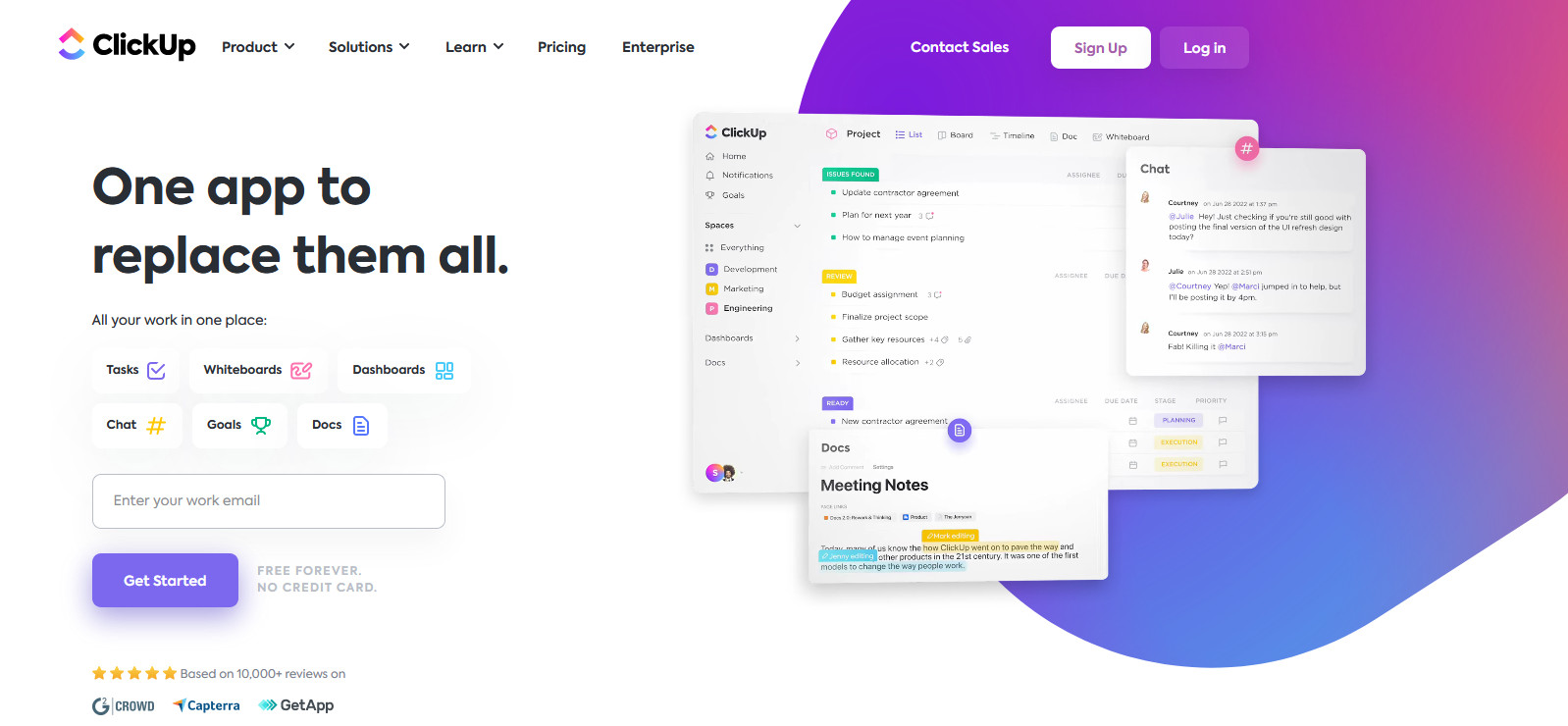
Today, ClickUp is a serious competitor to other task managers. This is evidenced by numerous positive reviews about the service, posted both on the official page of the company and on third-party resources. With an intuitive and highly customizable interface, it suits just about anyone, from the freelancer to a large software development company.
One of the key benefits of ClickUp is its extensive knowledge base. Its website contains detailed information on the application of each platform feature. Another benefit is flexibility. Workspaces and boards here are finely tuned to the needs of each user. Additional tools and functions can be added as needed.
The ClickUp service is used by world-famous large companies (for example, Google, Nike, Uber, Airbnb), as well as thousands of other businesses around the world. During its existence, it has repeatedly received honorary recognitions and awards, in particular, according to the authoritative resource G2, which publishes software reviews, it was named the fastest growing system in 2020.
ClickUp vs Monday: Service Comparison
Before comparing Monday vs ClickUp in terms of individual characteristics, let's list what they 100% have in common:
- Customizable dashboard.
- Many training materials available both on official and third-party resources.
- Availability of a mobile application.
- Integration with Google calendars and similar platforms.
- The ability to effectively distribute the workload for the team.
- The ability to see who is currently "sitting" in the network, and track the tasks that are currently being worked on.
Now consider the functionality and characteristics of both services from the perspective of Monday com vs ClickUp in more detail.
Usability
The developers of ClickUp and Monday.com understood that the ease of use of the task manager was a key priority. The users can feel it already at the first contact with the service, when they begin to learn how to work with it and apply the first sets of tools. In this parameter, both platforms deserve equally high marks.
The interface of Monday.com and ClickUp is intuitive, the functionality is simple, and it is easy to interact with it. Working with both programs is mastered quickly and does not cause any particular difficulties in the process.
Toolbar
ClickUp has a highly customizable toolbar, the elements of which can be adjusted according to personal needs or specifics of working in a particular company. Here the user gets access to a calendar that allows you to organize all projects in order of importance, and tasks - in order of completion. If this display format does not suit you, you can always choose one of the alternatives: for example, a list or a kanban board with a classification of tasks by work status (“Open”, “In progress”, “Review”, “Closed”, etc.).
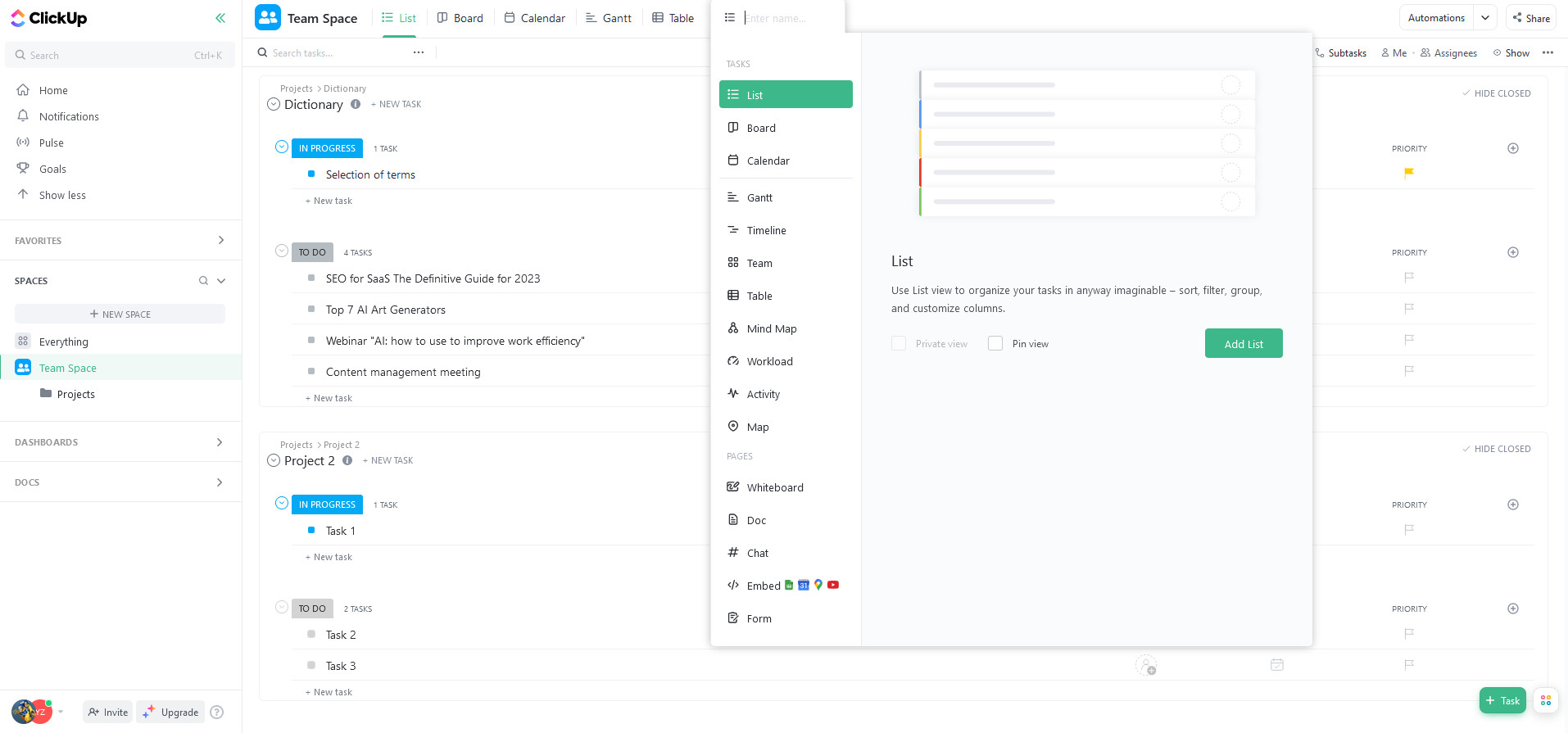
The "View" section in ClickUp offers different formats for displaying tasks: a kanban board, a list, a calendar, a Gantt chart, a timeline, a mental or regular map, a table, and so on. For the convenience of managing them, it is possible to accompany each of them with tags. In addition, ClickUp allows you to prioritize tasks so that the level of urgency is immediately clear. Red flags indicate those that need to be done immediately. Yellow – with a high level of urgency. Blue – with normal (current tasks). Gray – with low (what is worth doing after the completion of red, yellow and blue). All this increases the clarity and coherence of the team's work, and also allows you to avoid a number of misunderstandings that arise in the process.
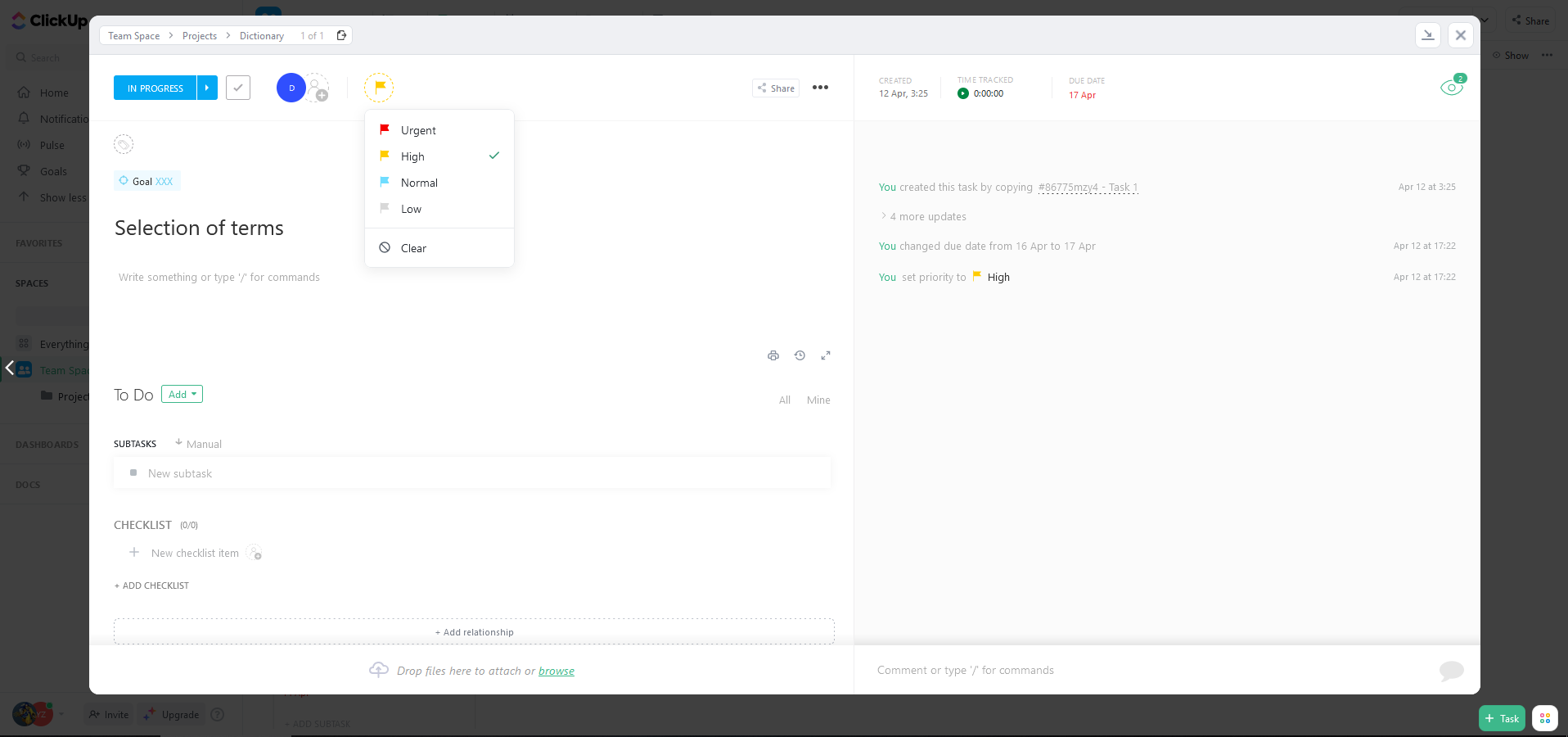
The Monday.com toolbar is similar in many ways to the one that ClickUp has. All tasks here are the same, organized on the boards. For different projects, it is convenient to open separate ones. Among the alternative formats for organizing workflows, you will see the same Gantt chart, spreadsheet, calendar, kanban board, and other options. You can select several formats at once and switch between them. For example, when moving from a spreadsheet or kanban board to a calendar, it is convenient to keep track of which tasks need to be done first.
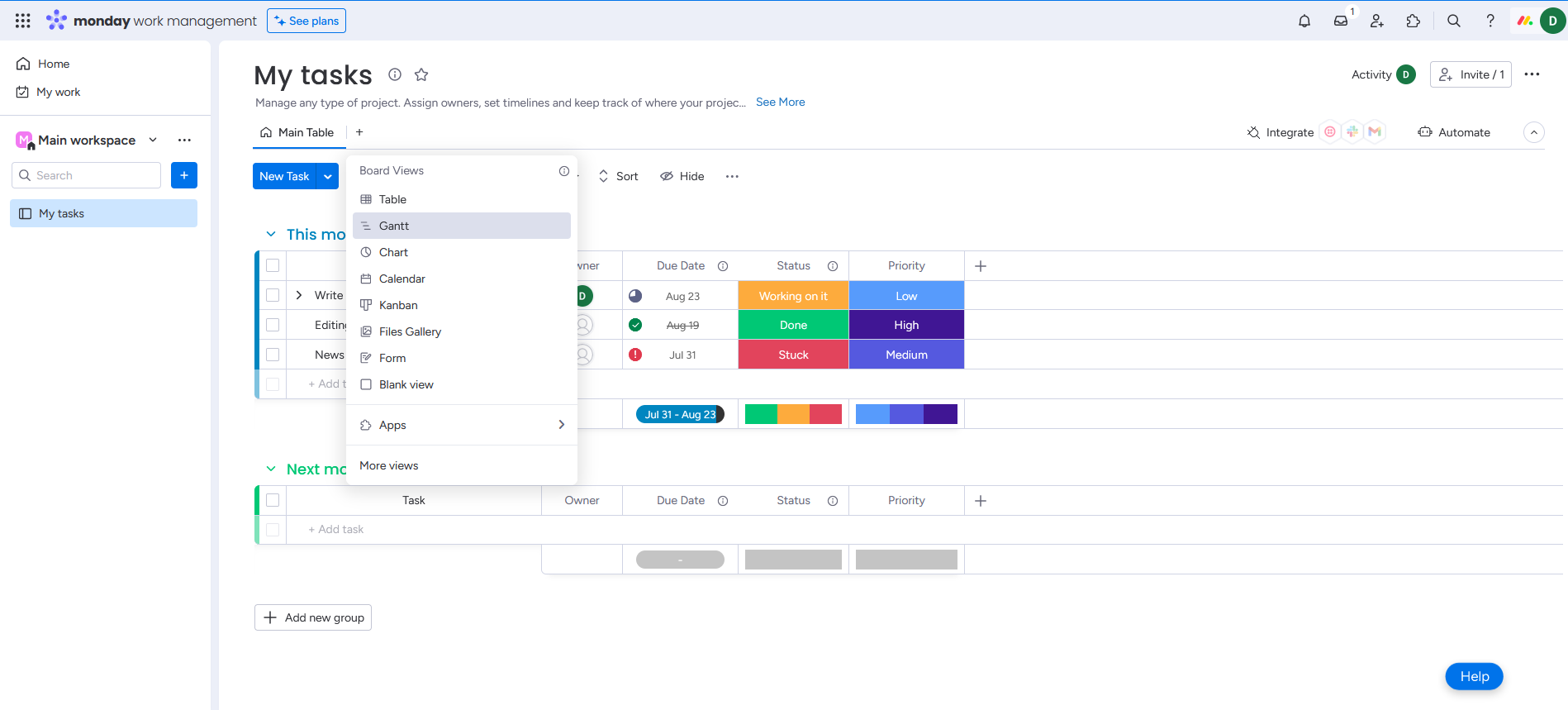
As for the design of the priority of tasks, here it is marked not with flags, but with color highlighting. The "High" level is indicated in dark purple, Medium – in blue, Low – in light blue. Unlike ClickUp, task statuses are also brightly highlighted in Monday.com: “Done” is green, “Working on it” is yellow, “Not Started” is gray, and “Stuck” is red.
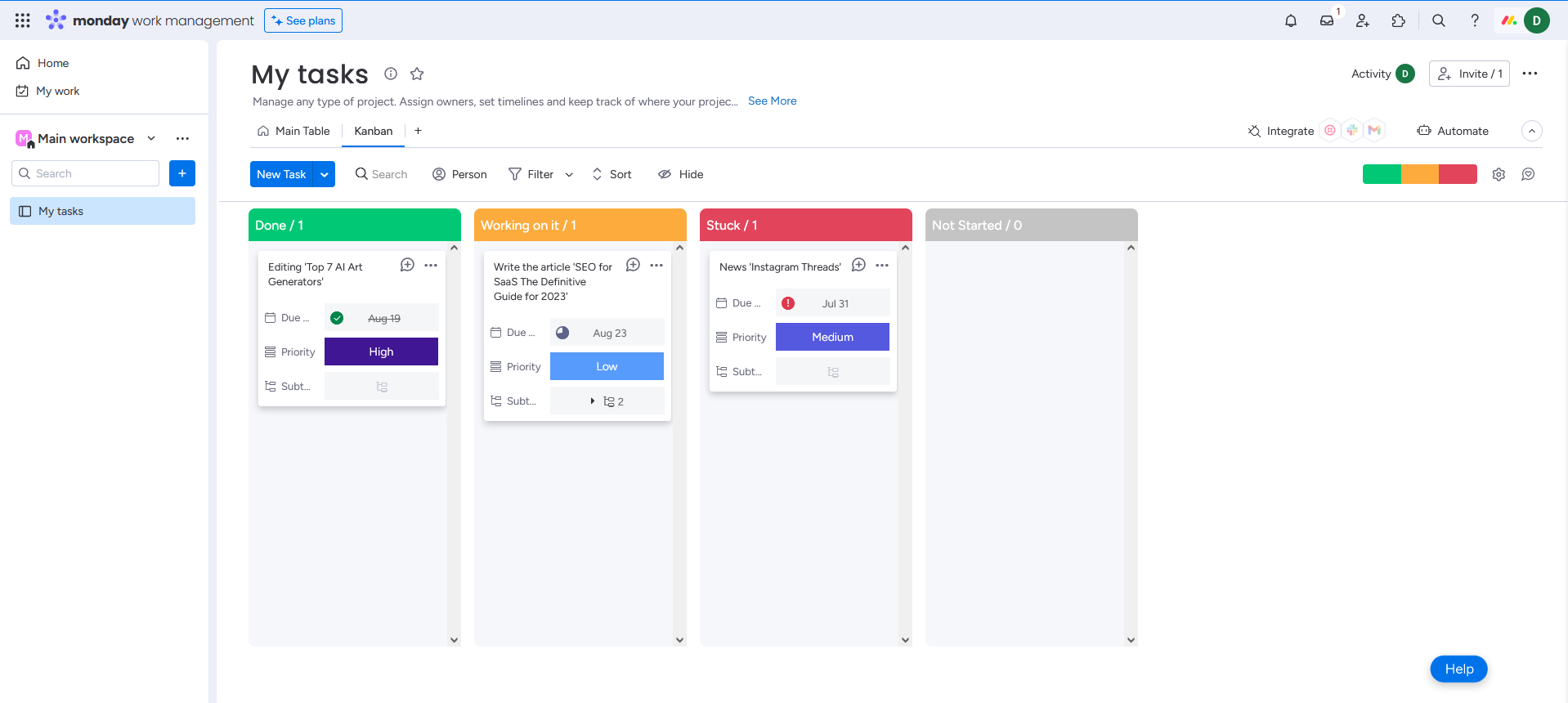
Combines both platforms by providing users with the most customizable workspace with the ability to drag and drop individual widgets. In this comparison, Clickup vs. Monday the second wins by a small margin: it just does a better job of color coding. In all other respects, both services are about equally good.
Task and Project Management
The ClickUp task manager can become a full-fledged assistant not only to the head of the company, but also to its ordinary employee. It does an impressive job of managing projects of any size, allowing you to create to-do lists, assign them to team members, and monitor progress from any device.
ClickUp features make it possible to break large projects into separate smaller parts, and, in turn, divide them into tasks. This systematization makes it easier to manage them, track progress and identify weaknesses.
Structural components of ClickUp:
- Workspace. This is where all the projects you create are located.
- Space. The first level of workflow categorization. It is very convenient to dedicate a separate space to each department of the company.
- Folder. Combining tasks into groups by goals, directions or topics.
- List. Specific tasks.
During the initial setup of the workspace, you will be provided with over 1000 ready-made templates, divided for ease of selection by the type of structural component (“Space”, “Folder”, “List”, “Task” and others) and areas of activity (“Marketing”, “ Project Management", "Engineering and Product", "HR and Recruiting", "Creative and Design", "Personal use" and others). You can also choose a template while working with the service. To achieve this, you just need to go to the workspace menu by clicking on the ellipsis icon "Space settings" next to its name (located in the left sidebar).
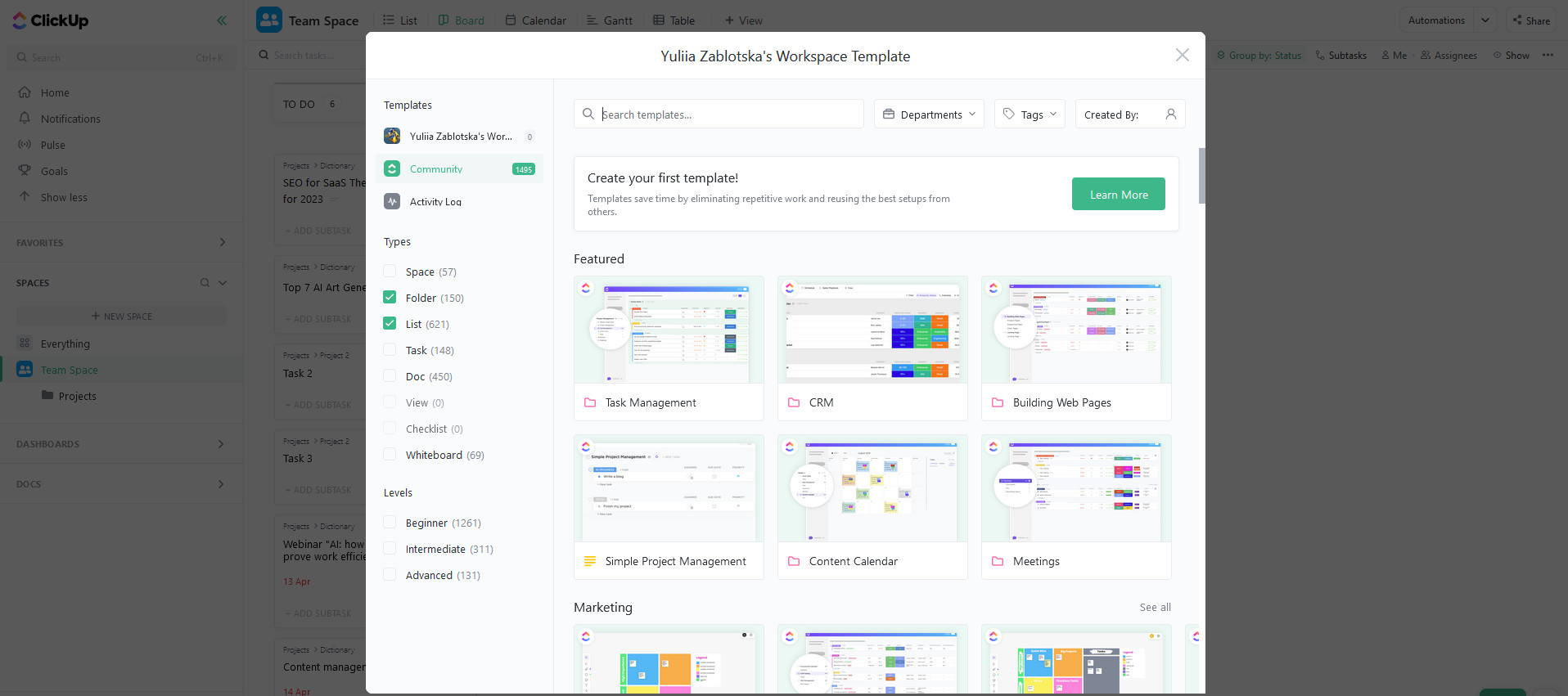
While in the workspace, you can create as many tasks as you like and assign them to responsible employees. For each of them, you can set statuses that determine the state of work on them currently, and set deadlines. In addition, here it is possible to set the priority of tasks by marking them with flags, the color of which indicates the degree of urgency of execution.
Project and task management in Monday.com is carried out according to the same principle as in ClickUp. When you first set up your workspace, this service will provide you with a variety of ready-made templates. You can use them to decorate it to save time that you would spend organizing it yourself. For convenience, they are divided into thematic categories: "Marketing", "Content production", "Project management", "Sales and CRM", "Freelancers", "Design", "Software development", "HR" and many others. By choosing any of them, you get a complex environment, the structure of which allows you to manage several complex projects at once, control the budget, correctly distribute the workload, monitor the adequacy of resource allocation and employee productivity.
Everything you need to work, you can see on one board. This is much more convenient than digging through numerous folders and flipping through multipage files on a computer or in the cloud, constantly changing them, simultaneously giving tasks to employees in the messenger and receiving messages from them about their completion there. You can also choose a template while working with the service. To achieve this, click on the button with a plus sign next to the search column under the name of the workspace (in the left sidebar) and click on "Choose from templates".
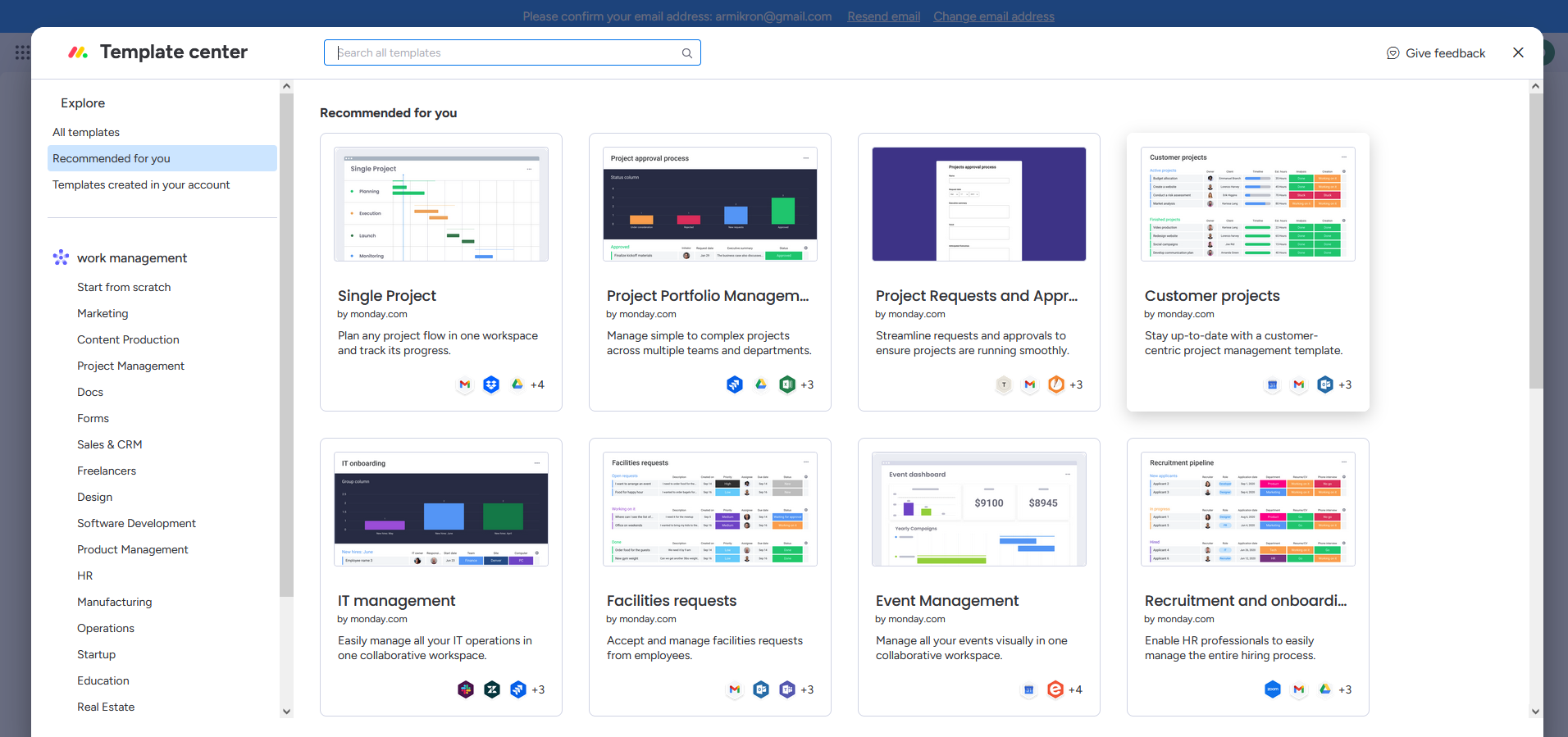
Structural components of Monday.com:
- Workspace. The location where all user-created projects are located.
- Board. The main structural unit, which, as a rule, is dedicated to one project or the work of one department of the company.
- Group. Combining tasks according to some principle (goal, subject, activity vector).
- Task. Here are specific tasks assigned to oneself (subject to individual use of the service) or employees.
In Monday.com, just like in ClickUp, you can set deadlines and prioritize tasks, as well as color-code their status for better visibility of progress. If necessary and appropriately configured, this platform will automatically send you reminders and notifications. In addition, it allows managers to see the entire workload of each team member and control how they cope with it.
Both services are simple and straightforward to use. They excelled in project and task management. Both platforms provide many useful project management tools, out-of-the-box templates and several workflow visualization formats. Each of them makes it possible to work as efficiently as possible in a team and clearly prioritize. Both Monday.com and ClickUp help their users to systematize their internal processes with a logical sequential branching: from large-scale projects to individual tasks.
Goal and Time Tracking
In ClickUp, the progress and goal tracking feature is one of the most interesting. Team leads can organize goals into folders and track their progress in a convenient dashboard. Once you've delivered a specific goal, here you can choose how you're going to measure its achievement. There are several measurement types to choose from:
- Number (any number like 1 or 2).
- True/False (done or not done).
- Currency (show me the money).
- Tasks (track completion of tasks).
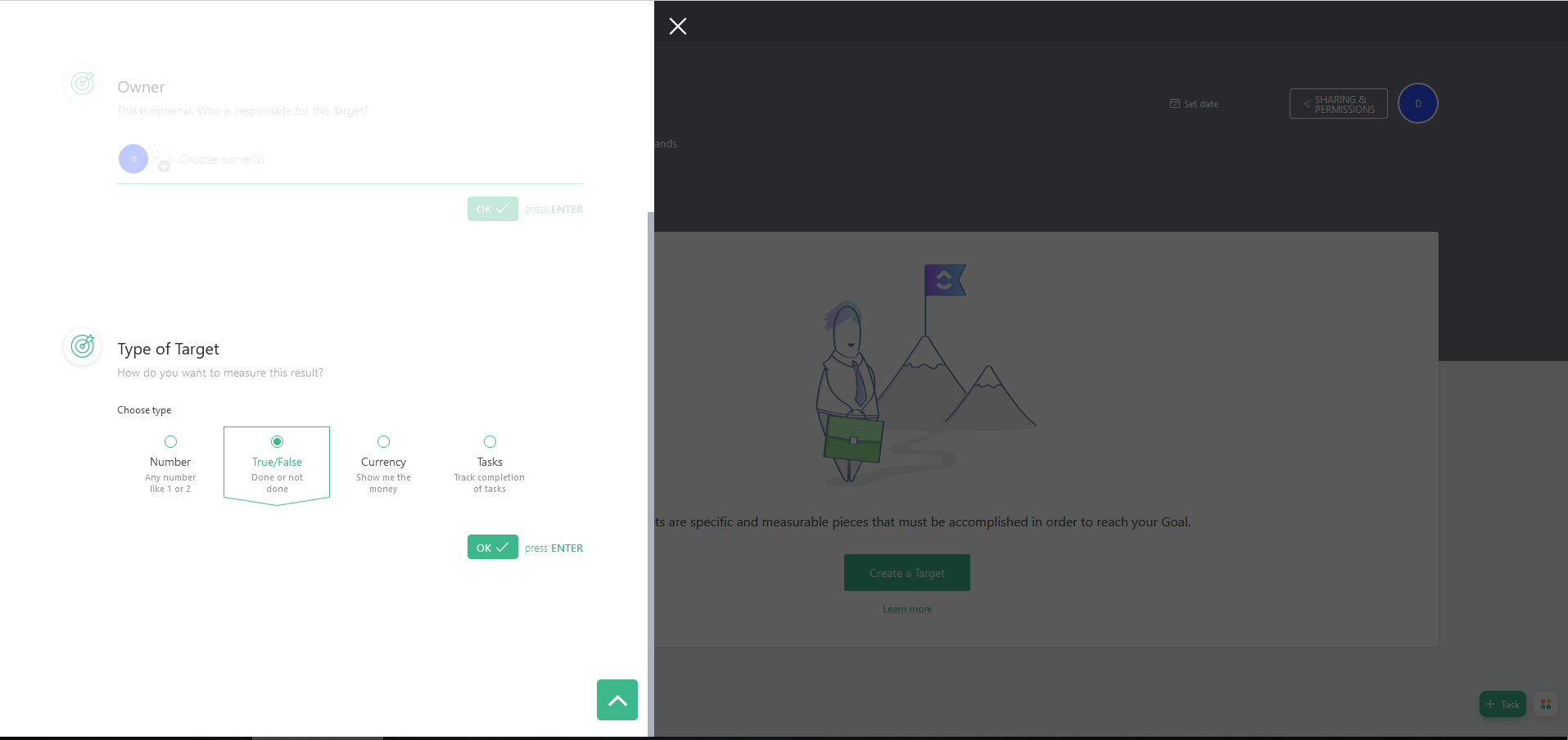
It is convenient to divide each major goal into intermediate ones and put them in front of individual employees or teams. Using this service, a team leader or manager can create "summary" dashboards that clearly demonstrate the time spent on various tasks and the degree of their readiness at the moment. In this way, you can monitor the progress of subordinates in achieving significant goals, the success of their passage of the path to it, as well as monitor compliance with deadlines and identify hidden problems.
ClickUp functionality for time tracking is available in all tariff plans and at all structural levels: from the workspace to a single task. True, if you need additional features (for example, somehow mark paid hours worked), you will have to take the Business plan. In addition to the "native" built-in functions for time control, ClickUp has support for integration with third-party services – Clockify, Harvest, Timely.
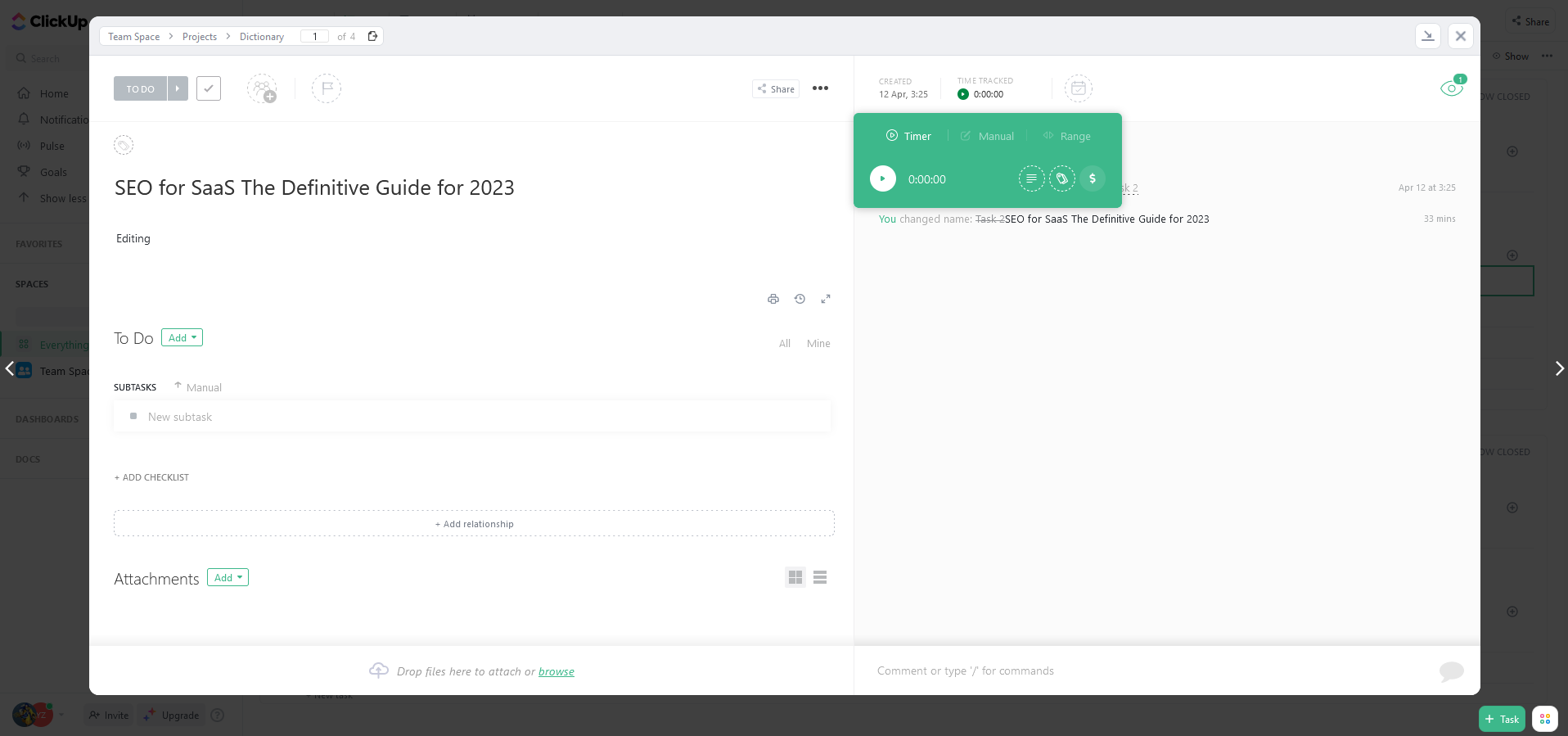
Monday.com offers its own approach to tracking progress and time spent on work. By choosing workflow display formats such as charts, graphs and timelines, you can observe in detail how you went to achieve each goal you set or how your subordinates did. Progress in completing tasks here is indicated by colour, making it easy to understand what is already done, what is being worked on right now, and what is “hanging” and requires special attention. Such marking helps to concentrate on the implementation of priority tasks and stay on schedule. To control the time in the "Main table" format, you can add another column "Time tracking" or "Hour".
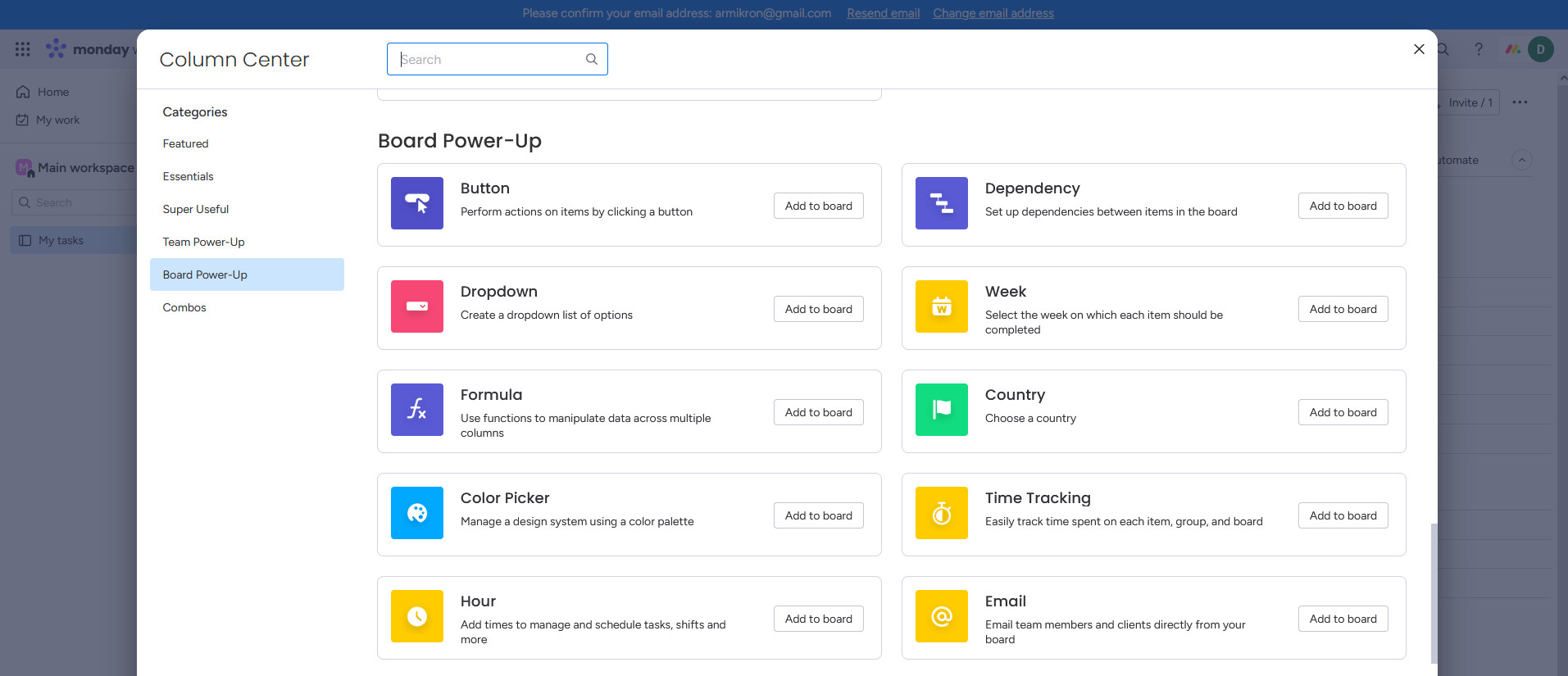
Team leaders and department heads should like this space organization format like “Workload”. It makes it possible to see how tasks are distributed among employees, to understand whether everything is in order with the level of workload, and to ensure that distortions do not occur. "Workload" is a great way to check the load of subordinates and prevent cases of its inadequate increase.
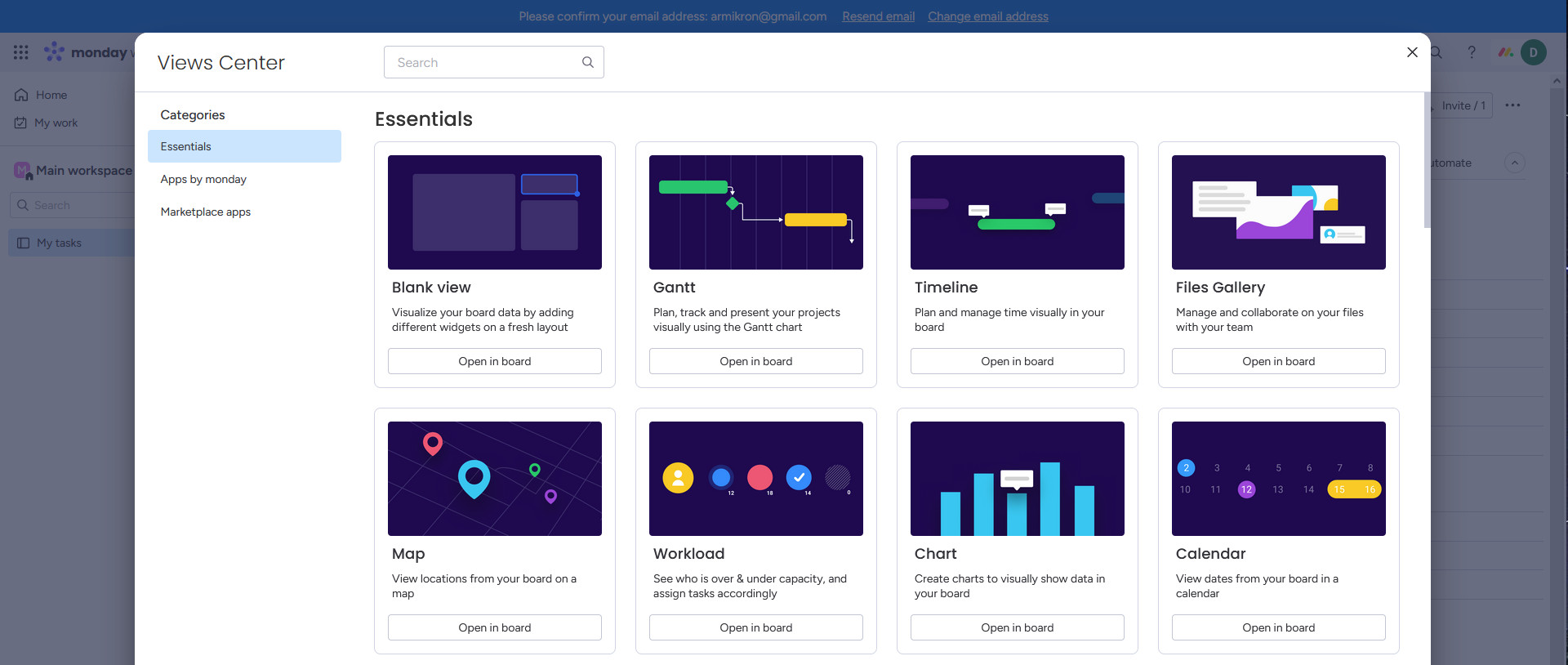
Tracking your goals and time on Monday.com is a relatively easy, intuitive process. However, in terms of functionality, this service is still inferior to ClickUp, which offers its users a wider range of tools for monitoring progress, achieving goals, and managing time.
Reporting and Analytics
ClickUp is considered one of the best task managers exists today in terms of providing analytical data and various reports. The tools of this service make it possible to easily monitor progress not only for a single task, but for the whole project. For example, the "Pulse" function (located in the left sidebar) provides a detailed, understandable report on the level of activity of employees. Just by looking at it, you will immediately see who is currently “sitting” online and what task they are working on.
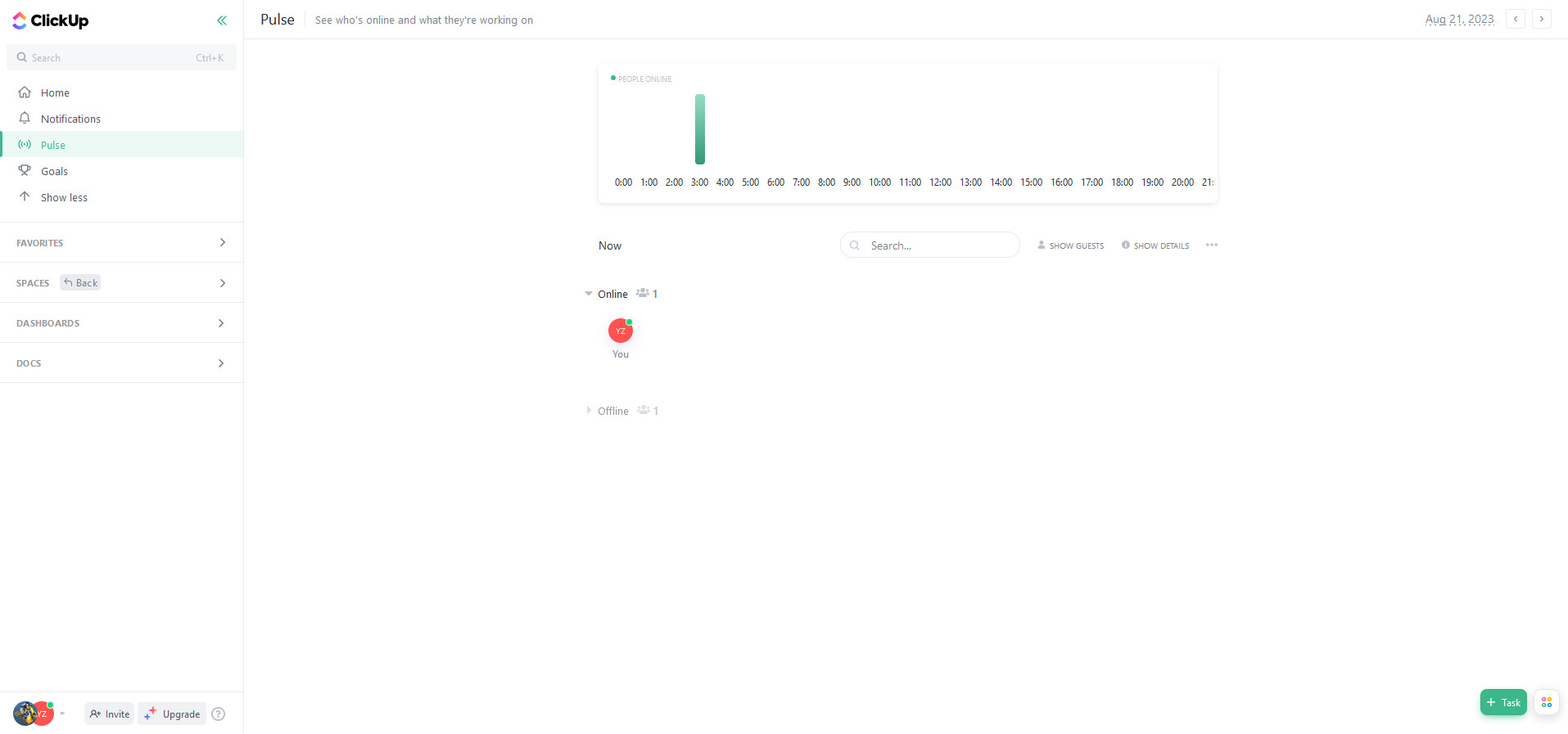
The "Critical Path & Slack Time" feature displays tasks that must be done on time, and those that, in principle, can be postponed. You can connect it by selecting the Gantt chart format. Click "Show" in the toolbar and move the slider next to "Critical Path" or "Slack Time".
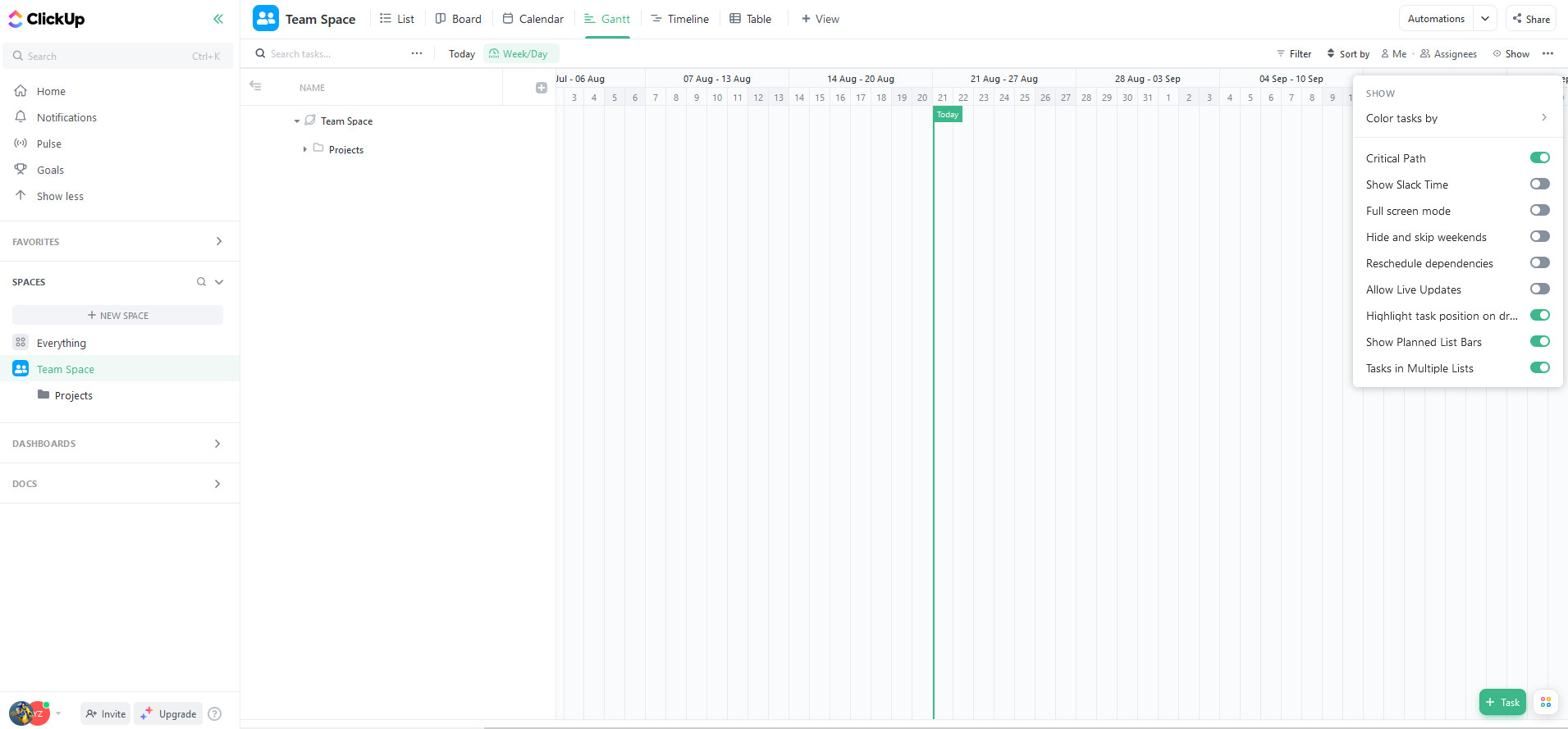
ClickUp provides team leads and department heads with many ways to easily customize reports. For example, you can change their time ranges to view important data for specific days or months. In addition, this service allows you to create reports that show the performance of each team member.
The Sprint Points report is one of the best project management tools. It can be used if you apply gamification techniques in your business environment. This report allows you to track the number of points your employees have earned. Access to the ability to add points to tasks and subtasks and assign them to each performer individually gives the application Sprint Points ClickApp. You can connect it to your Workspace like this:
- Click on your avatar in the workspace.
- Click on ClickApps.
- Select Sprint Points (move the slider).
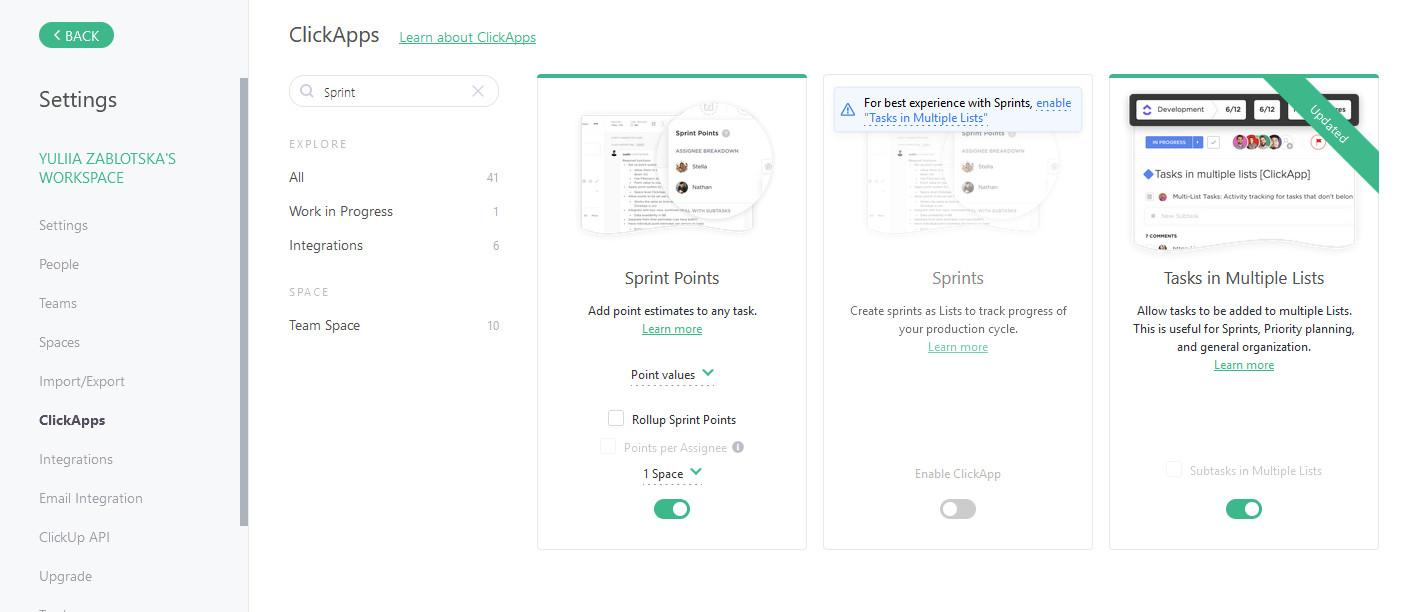
Monday.com's reporting approach is not much different from that offered by ClickUp. In addition to graphs and charts, which you can access directly in the workspace, the service also provides many applications – both free and paid. The charts here can be used for simple reports. If you need large-scale analytics or detailed reporting, it is better to use project management tools Monday in applications format. Finding them is easy:
- Click on the plus sign («Add View»).
- Select "More views".
- In the Views Center window, select the apps you want (for example, Goals - Beta, Analytics & Reports, Agile Reports, Bottlenecks) and add them to your board.
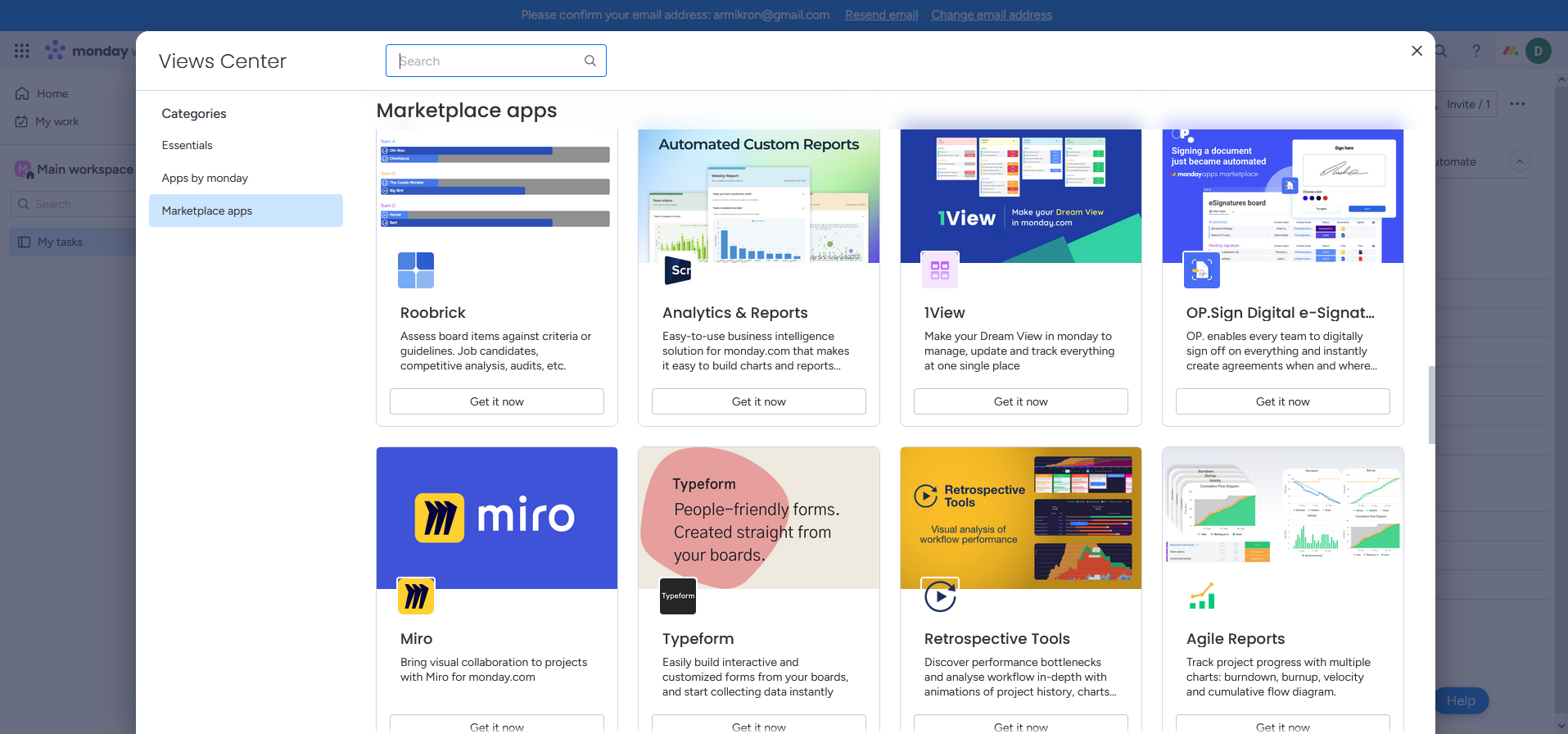
In addition to reporting, Monday.com gives a complete overview of the team's work and shows the specifics of workload distribution through a special format for organizing workflows "Workload". We have already talked about it in the section above.
ClickUp and Monday.com features related to analytics and reporting can be considered roughly the same. The only difference is that ClickUp provides better access to them. Almost everything you need is right in the workspace. But on Monday.com, the same functions must be connected as separate applications.
Integrations
Monday.com and ClickUp are powerful and almost self-sufficient task managers. And yet, in the process of working with them, to obtain better results, in most cases it becomes necessary to connect third-party tools and systems. This is absolutely normal and does not mean their inferiority. On the contrary, it indicates flexibility.
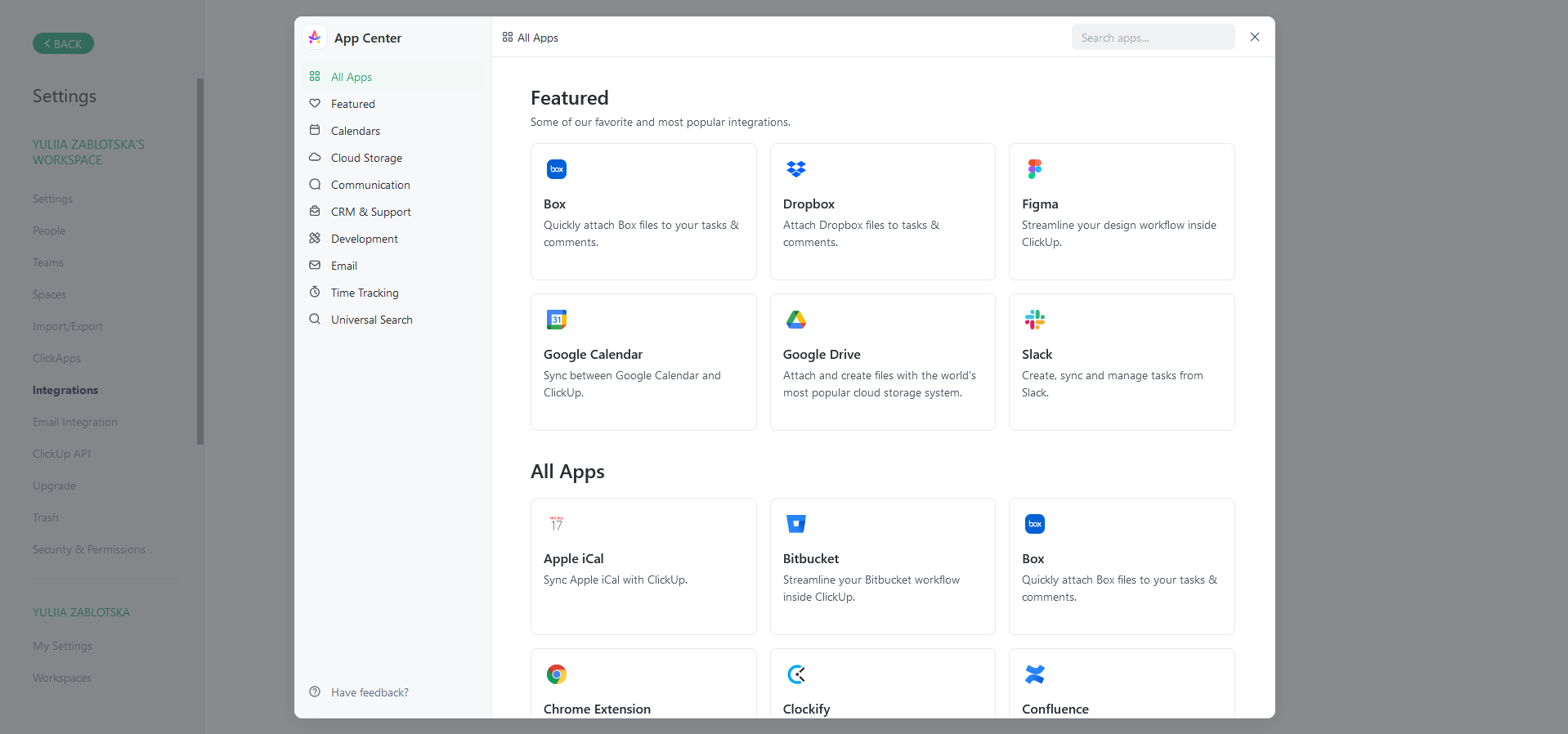
ClickUp provides its users with the ability to integrate with more than 1000 third-party services: Google Calendar, Google Drive, Dropbox, Outlook and many others. In addition, this platform allows you to create integrations with the systems you need through the API, as well as through the SaveMyLeads integrator service. For example, if you're using ClickUp to work with leads generated from Facebook, you can automate the creation of tasks, thus avoiding wasting time on repetitive actions. The SaveMyLeads service will itself create a task for each lead that came through this social network, without your participation. You only need to take a few minutes to set up, and the system will work for you 24 hours a day, seven days a week.
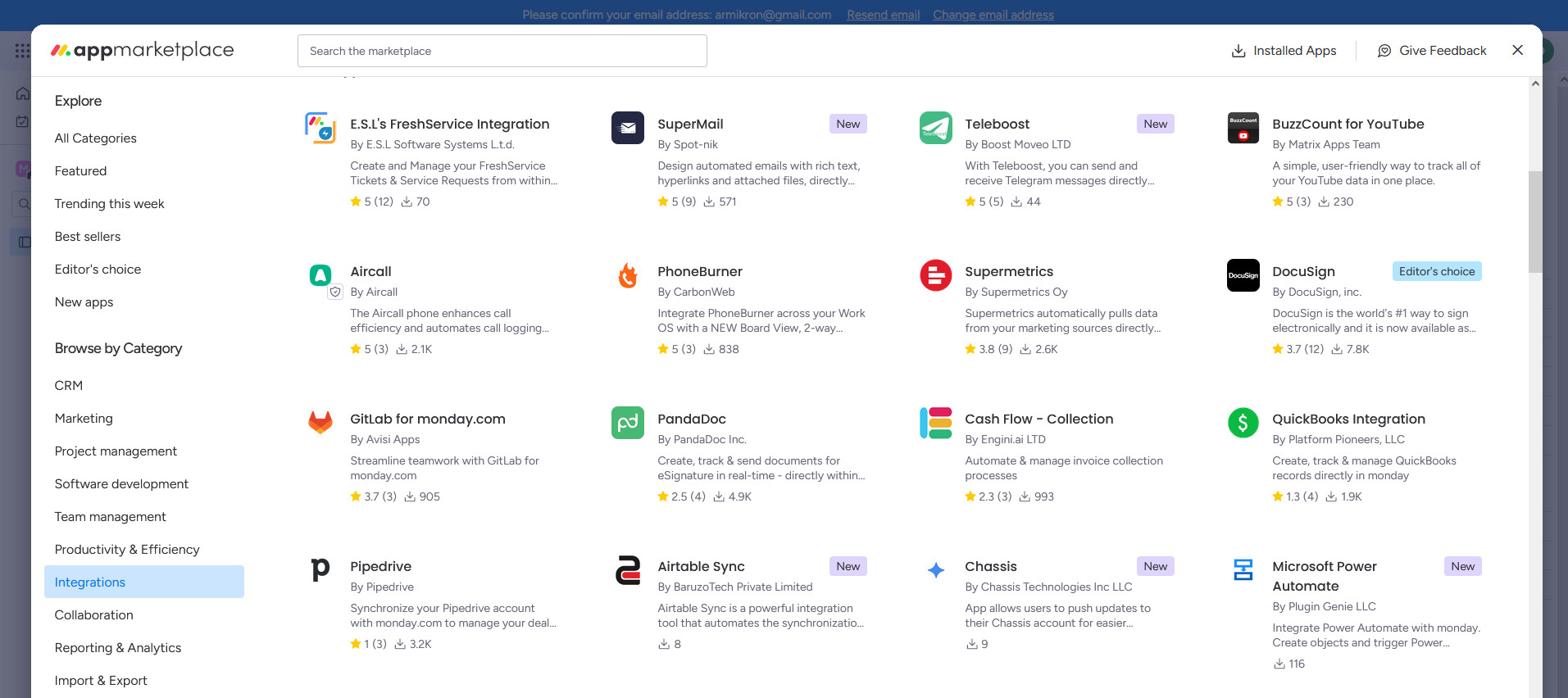
Monday.com integrates with a number of CRM providers, software development services, marketing services and many other platforms. If necessary, you can connect Microsoft Teams, Google Drive, Dropbox, Salesforce, Jira and more to it. In addition, it allows you to automate tasks by integrating with third-party services and offering ready-made “recipes”. For example, your Slack team members will be automatically notified when a task on Monday.com reaches the status "Completed". If you use Monday.com to generate leads from Facebook and want to automate it, you can use the SML integrator service. It will track new leads from this social network, process applications from potential customers and immediately transfer their data to Monday.com.
In terms of integration between both services, we put an equal sign: their capabilities in this perspective are equally wide. The advantage of ClickUp can be considered an open API, and Monday.com is the availability of ready-made "recipes" for automation.
User Support
Monday.com and ClickUp have a large self-service knowledge base. It gives answers to almost all questions that most often arise in a beginner in the process of working with the service.
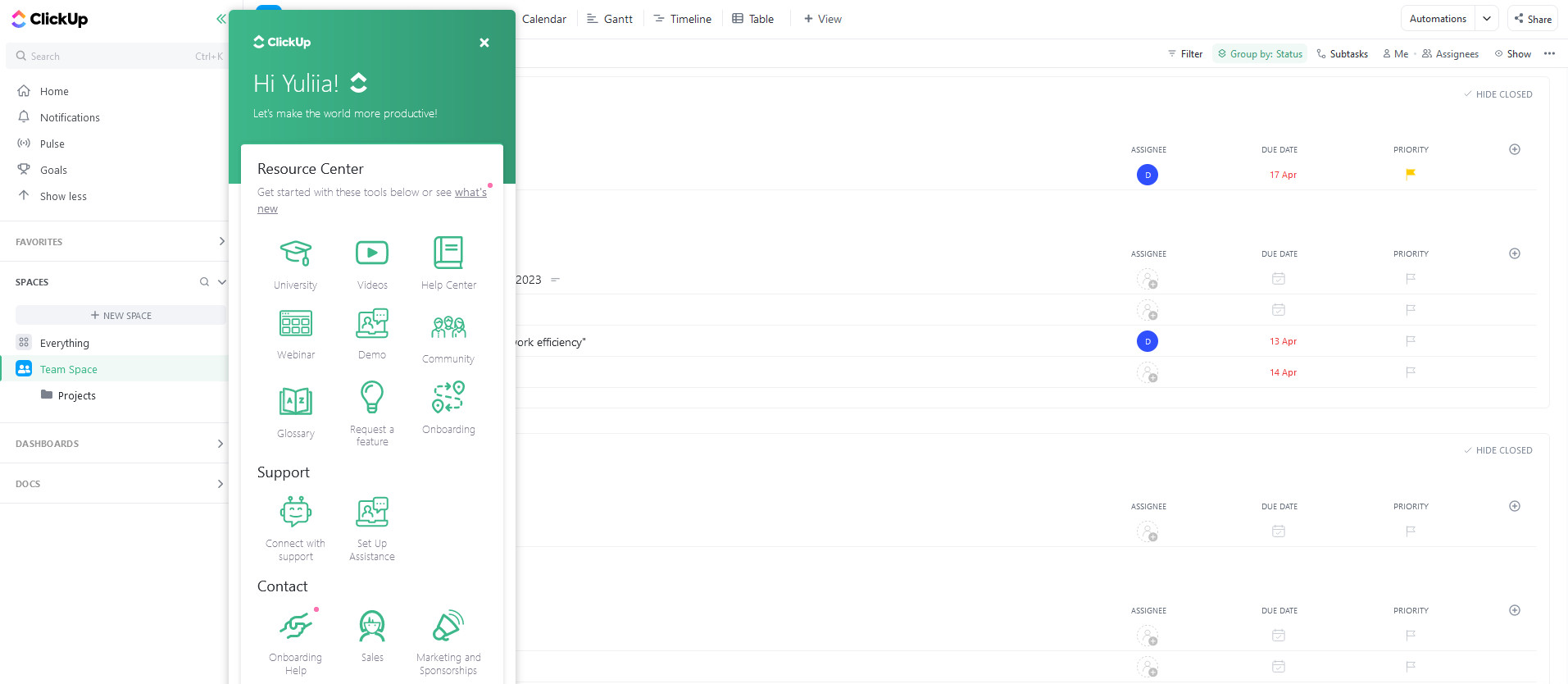
Both platforms provide access to tutorials, training videos, webinars. ClickUp even opened an entire virtual university, and Monday.com an academy. The only difference between them is that ClickUp has a dictionary of terms and concepts, as well as a virtual tour of the service with a guide. All this effectively helps to solve simple problems, increasing user loyalty.
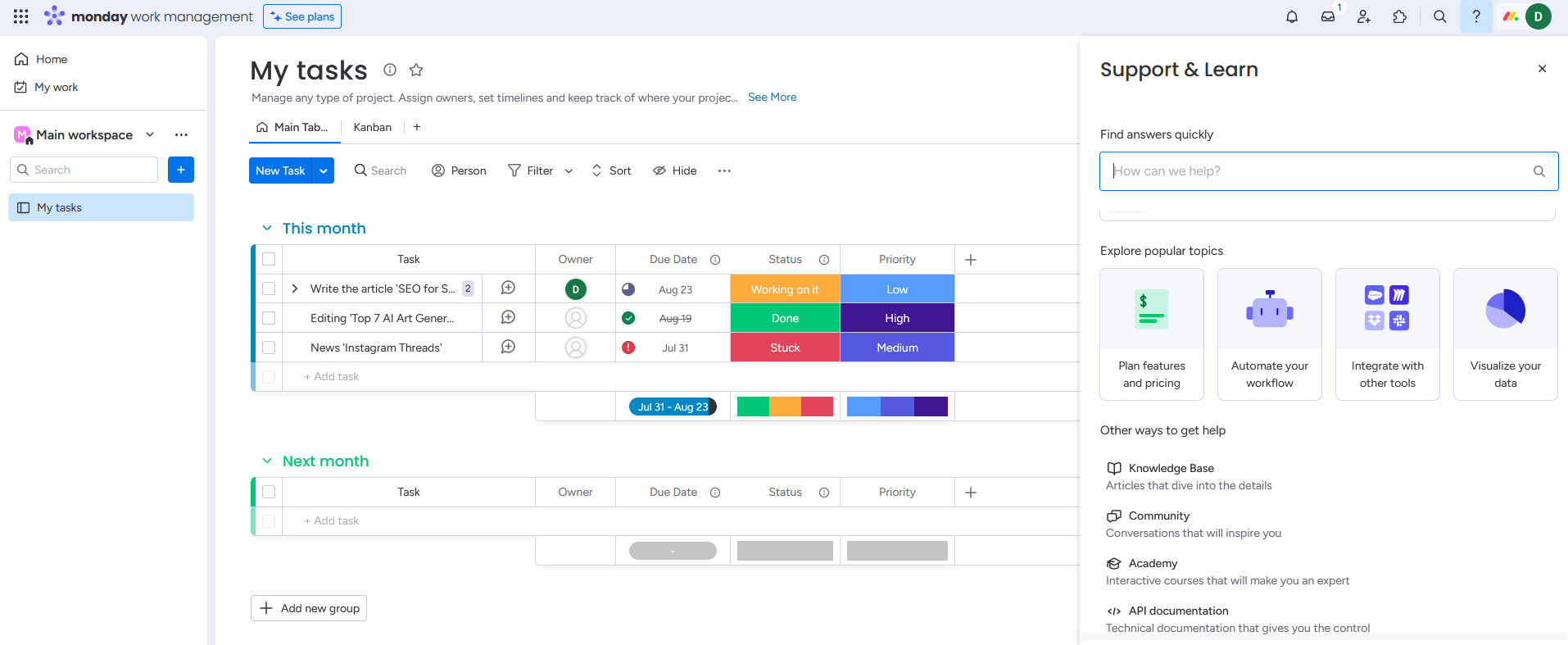
Both platforms provide 24/7 technical support to users, regardless of the tariff plan they choose. Monday.com, in addition to the chat, additionally offers communication with the technical support service by phone, and ClickUp offers communication with a verified consultant.
Security and Privacy
Today, the security of online services is one of the most important criteria that people pay special attention to when choosing. Both platforms we compare are fairly well protected.
ClickUp uses the TLS 1.2 encryption protocol and the AES-256 encryption algorithm to securely protect user data while it is stored and in transit from Amazon Web Services cloud servers. It meets all the requirements for SaaS providers with SOC 2 certification and also has ISO certifications. In addition, ClickUp offers multiple login options, SAML single sign-on, two-factor authentication, session management, and more.
Monday.com provides its users with the same level of protection. Data is stored in the same way on Amazon Web Services servers. The encryption protocols are the same. Like ClickUp, this service is SOC 2 compliant and has many ISO certifications. Everyone gets access to two-factor authentication, but Google authentication is only available to those who have purchased a subscription to the Pro plan and above. The single sign-on options are exclusive to those subscribed to the Enterprise plan.
Price
ClickUp and Monday.com pricing models are similar. Both services offer their users a free version, paid plans, and an enterprise plan with custom pricing.
Clickup pricing (the amount is indicated for one user per month, subject to payment for the year at once):
- Unlimited – $7.
- Business – $12.
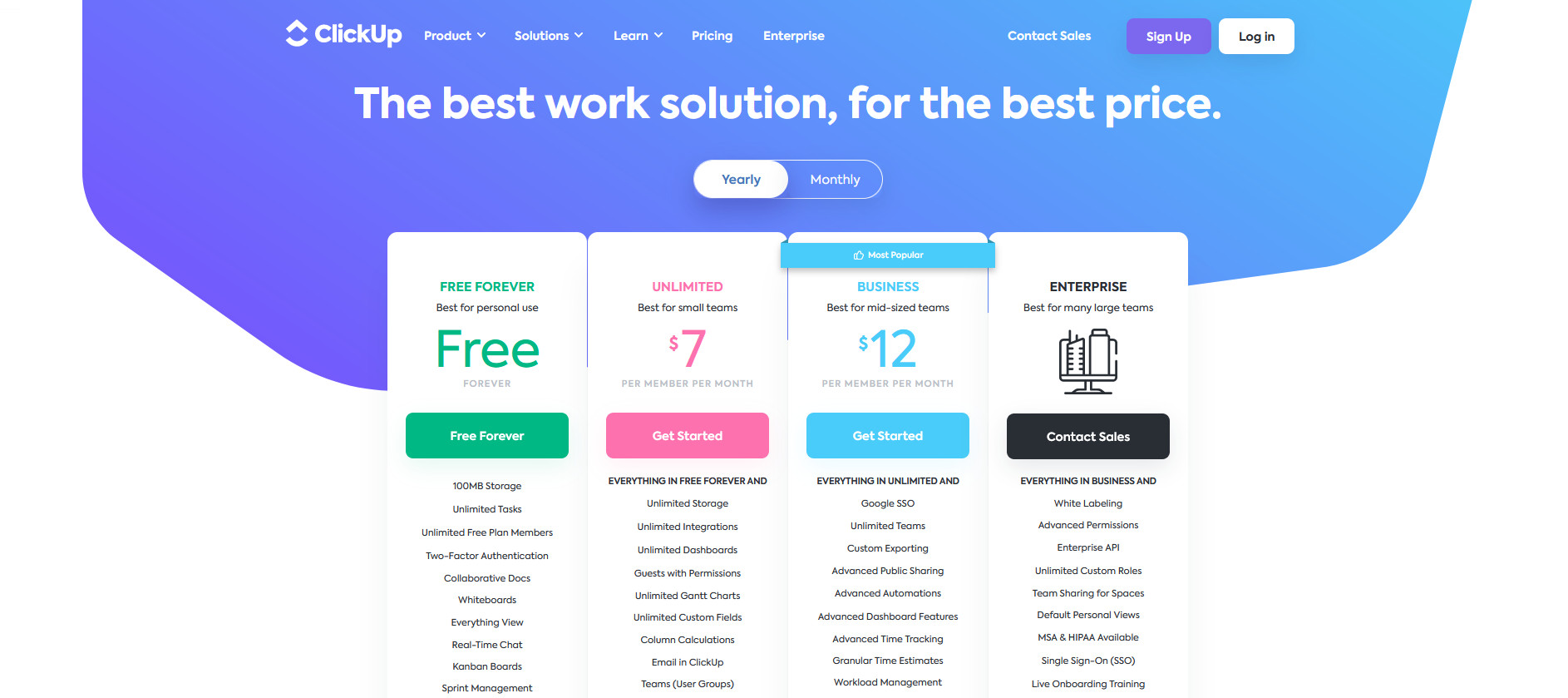
Monday.com pricing (the amount is indicated for one user per month, subject to payment for the year at once):
- Basic – €8.
- Standard – €10.
- Pro – €19.
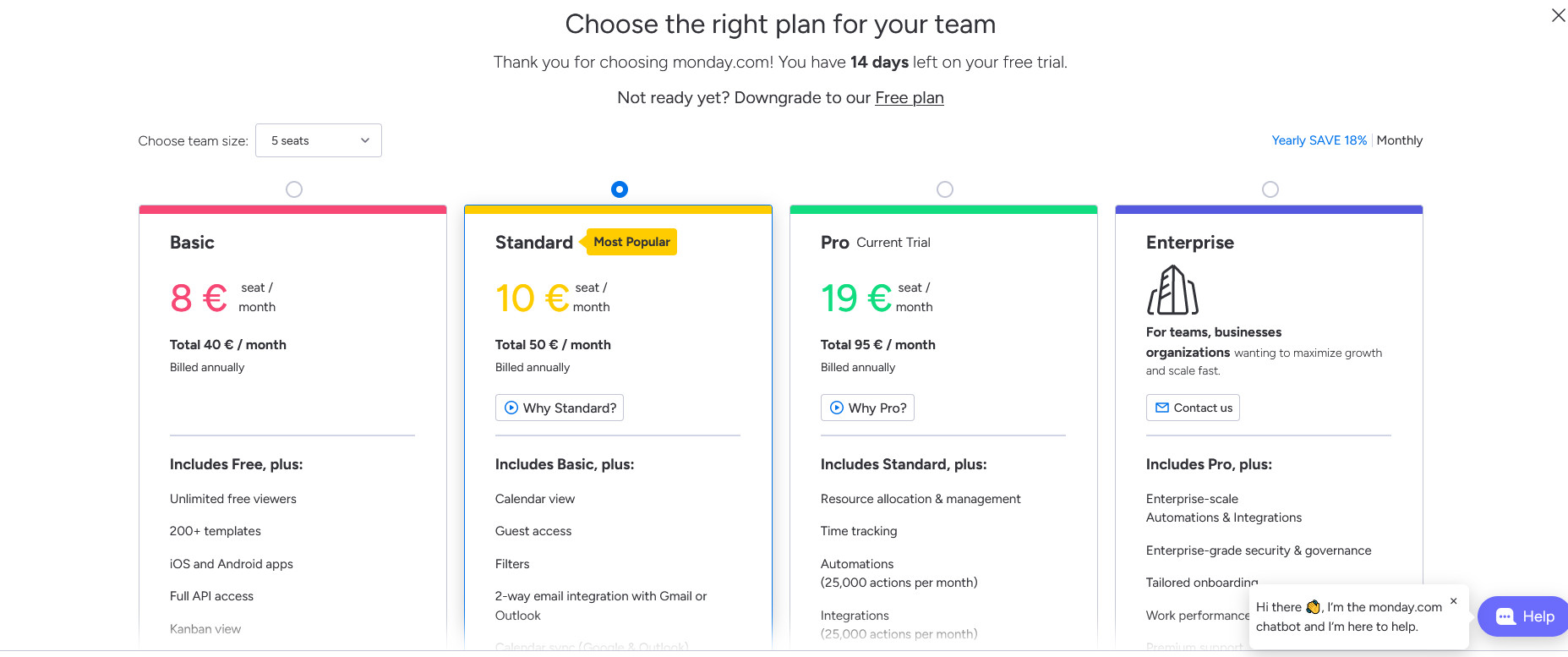
The free version of ClickUp is for individual use by one person. A similar version of Monday.com is designed for 2 users. In terms of file storage space it provides, Monday.com allocates 500 MB and ClickUp only 100 MB. True, while ClickUp allows you to create an unlimited number of tasks, and Monday.com sets a limit of 1000 units, compensating for it with the possibility of collaboration.
Summing up
Monday.com and ClickUp are rightly considered among the best task managers today. Both services have powerful functionality that allows both single professionals and large teams to increase their productivity. They are highly customizable, offer integrations with many useful platforms, and come with a free plan for beginners. You should prefer ClickUp if you prioritize detailed reports and high-quality analytics to track the productivity level of office workers, as well as the time spent on tasks by those who choose to work remotely. Monday.com is the best choice for those who are looking for the easiest, most intuitive service to manage both personal and work goals, as well as get comprehensive workload information.
SaveMyLeads is a simple and effective service that will help you automate routine tasks and optimize business processes. Stop wasting time uploading leads from Facebook manually – you can do it automatically, saving a lot of time and money. Eliminate routine from workflows and achieve more with minimal investment of money, effort and human resources.
